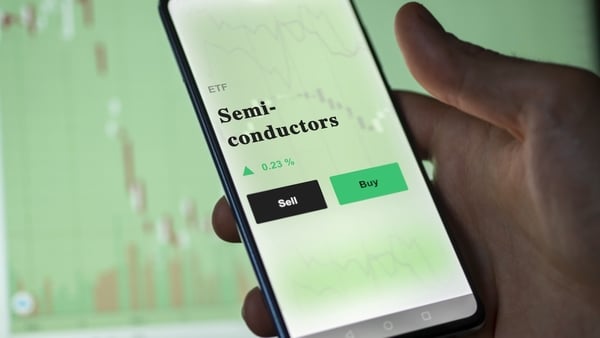Leveraged Semiconductor ETFs: Investor Exodus Before Market Rise

Table of Contents
Understanding the Risks of Leveraged Semiconductor ETFs
Leveraged ETFs aim to deliver amplified returns, typically 2x or 3x the daily performance of the underlying index. However, this amplification works both ways, magnifying gains and losses. This inherent volatility makes them a high-risk investment, unsuitable for risk-averse investors.
-
Daily Reset Mechanism: Leveraged ETFs reset their leverage daily. This means that even in a slightly negative market, the compounding effect of daily losses can significantly erode the investment over time. A -1% loss followed by a +1% gain doesn't equate to a break-even; instead, it results in a net loss due to the leverage.
-
Increased Risk in Sideways or Slightly Declining Markets: In markets that move sideways or experience slight declines, leveraged ETFs can suffer substantial losses, regardless of the underlying index's relatively stable performance.
-
Higher Expense Ratios: Leveraged ETFs generally have higher expense ratios compared to their unleveraged counterparts, further impacting returns.
-
Significant Capital Loss Potential: The amplified nature of leveraged ETFs means investors face the potential for significant capital losses in short periods, even with seemingly small fluctuations in the underlying semiconductor market.
These risks are particularly amplified in the volatile semiconductor sector. The industry is cyclical, highly susceptible to geopolitical events (like trade wars or sanctions), and sensitive to changes in global demand. Recent market fluctuations, such as the 2022 chip shortage followed by a subsequent inventory correction, perfectly illustrate how quickly fortunes can change, negatively impacting leveraged semiconductor ETF investors.
The Recent Investor Exodus: Causes and Analysis
The recent sell-off in leveraged semiconductor ETFs is a multi-faceted phenomenon stemming from various intertwined factors:
-
Inflation and Rising Interest Rates: Concerns over inflation and the Federal Reserve's response, including interest rate hikes, have dampened investor appetite for riskier assets, including leveraged ETFs.
-
Geopolitical Uncertainties: The ongoing geopolitical instability, particularly concerning US-China relations and the war in Ukraine, creates uncertainty in the semiconductor supply chain, impacting investor confidence.
-
Profit-Taking: After a period of substantial growth, many investors engaged in profit-taking, leading to increased selling pressure on leveraged semiconductor ETFs.
-
Increased Regulatory Scrutiny: Growing regulatory scrutiny of the semiconductor industry, including investigations into potential monopolistic practices, adds further uncertainty.
-
Negative Sentiment: Negative news coverage and bearish analyst predictions have fueled negative sentiment, exacerbating the sell-off.
(Insert chart or graph here showing investor outflows from leveraged semiconductor ETFs over a specific period.) This data visually reinforces the magnitude of the investor exodus.
Potential for Future Market Growth and Investment Opportunities
Despite recent setbacks, the long-term growth potential of the semiconductor industry remains compelling:
-
High Demand Across Sectors: Semiconductors are essential components in various rapidly growing sectors, including artificial intelligence (AI), 5G networks, and electric vehicles (EVs), driving persistent demand.
-
Government Support: Governments worldwide are investing heavily in semiconductor manufacturing through subsidies and initiatives, aiming to boost domestic production and reduce reliance on foreign suppliers.
-
Technological Advancements: Ongoing technological advancements continue to push the boundaries of semiconductor technology, creating new opportunities and driving innovation.
-
Industry Consolidation: Consolidation and mergers within the semiconductor industry could lead to greater efficiency and profitability.
The potential for a market rebound is significant, making leveraged semiconductor ETFs potentially attractive in a recovering market. However, investors must proceed with extreme caution, fully aware of the inherent risks. Alternative investment strategies, such as investing in unleveraged semiconductor ETFs or individual semiconductor stocks, offer potentially less volatile exposure to the sector's growth.
Strategic Considerations for Investors
Considering leveraged semiconductor ETFs requires careful planning and a realistic assessment of your risk tolerance:
-
Due Diligence: Thorough due diligence is paramount. Understand the specific risks associated with the chosen ETF, including its leverage factor and expense ratio.
-
Diversification: Diversify your portfolio to mitigate risk. Don't concentrate your investment solely in leveraged semiconductor ETFs.
-
Alternative Options: Explore alternative investments, such as unleveraged ETFs or individual stocks, to reduce risk.
-
Market Monitoring: Actively monitor market trends and adjust your investment strategy accordingly. Be prepared to exit your position if the market moves against you.
-
Long-Term Perspective: Leveraged ETFs are generally not suitable for short-term investments. A longer-term perspective is crucial.
Before investing in leveraged semiconductor ETFs or any leveraged investment, always seek professional financial advice. A qualified advisor can help you assess your risk tolerance, develop a suitable investment strategy, and understand the complexities of these instruments.
Conclusion
The recent investor exodus from leveraged semiconductor ETFs highlights the inherent risks associated with these instruments, particularly in a volatile sector like semiconductors. While the potential for substantial gains exists, the amplified risk of losses cannot be overlooked. Understanding the daily reset mechanism, the impact of market fluctuations, and the importance of diversification is crucial. Consider exploring alternative avenues for exposure to the semiconductor market's growth potential. Don't let the recent downturn deter you from researching and potentially investing in leveraged semiconductor ETFs strategically, but always proceed with caution and a well-informed approach.

Featured Posts
-
 Prenajimanie Nehnutelnosti Romke Romovi Statistiky A Realita
May 13, 2025
Prenajimanie Nehnutelnosti Romke Romovi Statistiky A Realita
May 13, 2025 -
 Atalanta Vs Bologna Minuto A Minuto Serie A Fecha 32 En Tn
May 13, 2025
Atalanta Vs Bologna Minuto A Minuto Serie A Fecha 32 En Tn
May 13, 2025 -
 Ac Milan Vs Atalanta Prediksi Skor Head To Head Dan Starting Xi
May 13, 2025
Ac Milan Vs Atalanta Prediksi Skor Head To Head Dan Starting Xi
May 13, 2025 -
 Nba Draft Lottery Rules Explained Simply
May 13, 2025
Nba Draft Lottery Rules Explained Simply
May 13, 2025 -
 Health Department Issues Heat Advisory Rising Temperatures Prompt Urgent Warning
May 13, 2025
Health Department Issues Heat Advisory Rising Temperatures Prompt Urgent Warning
May 13, 2025
